Trigonometric Equation: sin x = c
The trigonometric equation $$ \sin x = c $$ is a basic trigonometric equation where x is the input for the sine function, and c is any real number.
This equation is defined only if the value of c falls within the range c ∈ [-1,1].
$$ -1 \le c \le 1 $$
If c lies outside the closed interval [-1,1], the equation has no solution because it does not match the sine function’s range.
Note: In trigonometry, the sine function only takes values between -1 and 1.
When the equation is defined, it has infinitely many solutions of the form α+2πk or π-α+2πk.
$$ x = \alpha + 2\pi k \vee (\pi - \alpha) + 2\pi k $$
To solve the equation, I’ll find the angle α using the inverse sine function, also known as the arcsine.
$$ \arcsin c = \alpha $$
The arcsine function returns the angle α such that sin α = c.
A Practical Example
Let’s check if this trigonometric equation has solutions:
$$ \sin x = \frac{1}{2} $$
The equation is defined because the constant term is within the sine’s range.
$$ -1 \le \frac{1}{2} \le 1 $$
Therefore, the equation has the following solutions:
$$ x = \alpha + 2\pi k \vee (\pi - \alpha) + 2\pi k $$
To find the angle α, I calculate the arcsine of 1/2, which equals π/6 (or 30°).
$$ \arcsin \frac{1}{2} = \frac{\pi}{6} $$
Next, I substitute the angle α = π/6 into the solution formula:
$$ x = \alpha + 2\pi k \vee (\pi - \alpha) + 2\pi k $$
$$ x = \frac{\pi}{6} + 2\pi k \vee (\pi - \frac{\pi}{6}) + 2\pi k $$
Graphically, these solutions appear as follows:
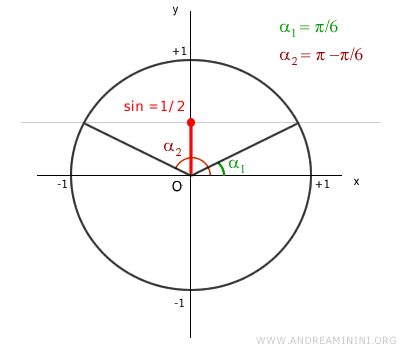
For both π/6 and π - π/6, the equation sin x = 1/2 holds true.
Because sine is a periodic function, we also include integer multiples k of a full circle, 2πk, in the solution set.
$$ x = \frac{\pi}{6} + 2\pi k \vee (\pi - \frac{\pi}{6}) + 2\pi k $$
Therefore, the equation sin x = 1/2 has infinitely many solutions of the form π/6 + 2πk and π - π/6 + 2πk.
The Proof
We begin by drawing the unit circle on the Cartesian plane.
The unit circle has a radius of 1.
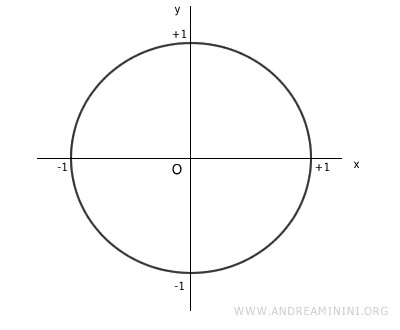
The sine function’s value is measured along the y-axis and ranges from -1 to +1 (the sine’s range).
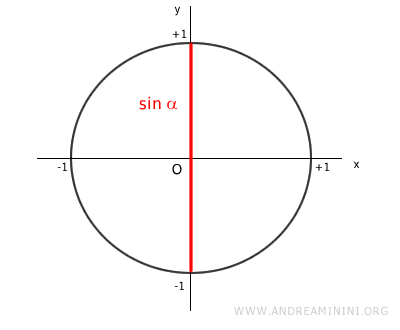
Taking any real number c, let’s examine if the equation has solutions.
If the value of c exceeds 1, the line y=c is parallel to the x-axis and does not intersect the unit circle.
As a result, there is no angle x that gives a sine value greater than 1.
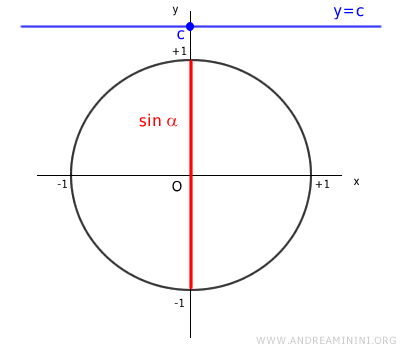
Similarly, if the value of c is less than -1, no angle x will yield the value c for sine.
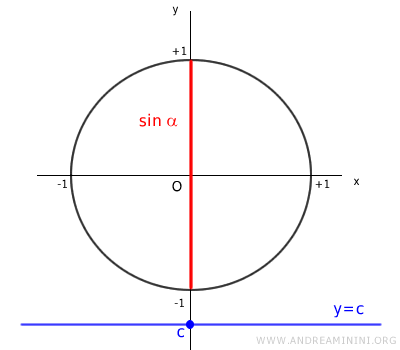
Therefore, the equation sin x = c is defined only if c lies within the interval [-1,1]
$$ -1 \le c \le 1 $$
Now, let’s consider a value of c within the interval [-1,1].
The equation y=c is a line parallel to the x-axis that intersects the unit circle at two points, P1 and P2.
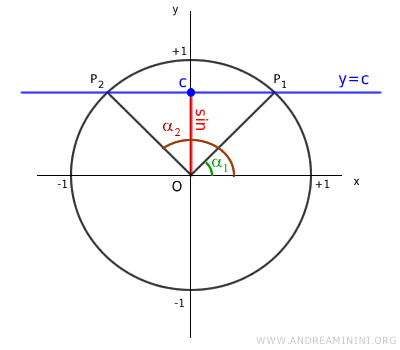
These points, P1 and P2, are endpoints of radii at angles α1 and α2.
Thus, for the value c, there are two angles α1 and α2 that satisfy the equation sin x = c.
$$ \sin \alpha_1 = \sin \alpha_2 = c $$
Both α1 and α2 solve the equation, so we can write:
$$ x = \alpha_1 \vee \alpha_2 $$
However, these aren’t the only possible solutions.
Sine is a periodic function that repeats its values every period of 2π.
We therefore include the sums of α1 and α2 with integer multiples of 2πk in the solution set.
$$ x = \alpha_1 + 2\pi k \vee \alpha_2 + 2\pi k $$
The angles α1 and α2 are associated angles for sine because they produce the same result, sin(α1) = sin(α2).
Thus, we can rewrite α2 as π - α1.
$$ x = \alpha_1 + 2\pi k \vee (\pi - \alpha_1) + 2\pi k $$
With only one angle α1, we can simplify further by writing α = α1.
$$ x = \alpha + 2\pi k \vee (\pi - \alpha) + 2\pi k $$
Thus, if c lies within the interval [-1,1], the equation sin x = c is defined and has infinitely many solutions of the form x = α+2πk or π-α+2πk.
$$ \sin x = c $$
Note: In cases where c = 1 or c = -1, the line y = c intersects the unit circle at only one point instead of two. The solution set includes these specific cases where $$ \alpha = \pi - \alpha $$
To find the angle α, I apply the arcsine function to both sides of the equation.
$$ \arcsin( \sin x ) = \arcsin c $$
The arcsine is the inverse of the sine function.
So, arcsin(sin x) = x
$$ x = \arcsin c $$
This way, I find the solution x to the trigonometric equation sin x = c.
And so on.
